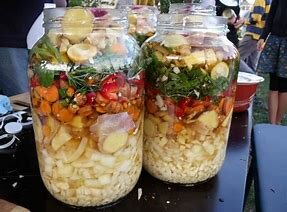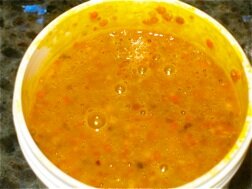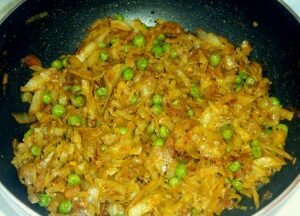RAW – Fermented – Vegan
Fermented Garlic in Honey – Ninniku Hachimitsu-zuke

This is a great cultured ferment for the winter season!
Easy to make and loaded with cold and flu fighting properties.
We recommend using RAW honey for the best taste and beneficial remedies. The honey is ready in as little as 2 to 3 days. Wait around a month or more to eat the garlic cloves and to allow full fermentation. The garlic will start to break down if left to sit to long, best to make smaller batches to use within a month
or two after fermenting.
The honey gives a nice sweet and strong garlic flavor
for many dishes.
Or if your a garlic fan you can eat the cloves, like candy.
The garlic infused honey, when thinned down with water, makes a great hot or cold drink to enjoy or as a cold remedy!
One can find many benefits to using this recipe for
health and well being.
What is Needed:
– 10 oz (300g) Fresh garlic
– 7 to 9 oz (200-250g) Raw Honey
Directions:
1. Start by separating the cloves of garlic, trim off the roots and outer skin. Make sure to remove the thin membrane under the outer skin.
2. Wash and pat the garlic dry, being careful not the break or damage the cloves. However, some will slightly break open the cloves to activate the allicin. The results seem to be the same, but whole cloves seem to have a longer shelf life.
3. Prepare a small packing jar by boiling in water to sterilize, also called a water bath.
4. Pack the garlic cloves into the sterilized container. Pour over the honey. Allow the honey to set for a minute and top off, making sure to cover all the cloves.
5. Cover with lid and allow to sit in a cool dark place. Fermentation times very, after a couple of days one should see bubbles forming in the honey mixture or even a foam on top.
6. For those who worry about botulism, you can also add a tsp of organic raw apple cider vinegar. This only needs to be done if the pH is to high. The mixture should read at 4.6 pH or lower, this should happen naturally.
After a months time, place in cold storage for better long term preservation. Enjoy!
~ Elderberries in Raw Honey ~

Black elderberries have a rich history in herbal medicine and elderberry syrup is a must-have in any natural cold and flu medicine chest. Elderberry syrup gained significant attention in the natural health community shortly after the H1N1 flu outbreak when a study was released demonstrating its ability to effectively inhibit this widespread strain of the flu (Roschek, et.al., 2009). It be bought already prepared, however, it is very easy to make at home.
What’s the Proper Way to Make Elderberry Syrup?
It’s crucial that the elderberries are from a reputable source, that all excess twigs or unripe berries are removed, and that the berries are cooked sufficiently to eliminate the toxin that is found in the seeds. Even when elderberries are dried before cooking and the syrup is strained, it is possible for this toxin to produce complications if the syrup is not cooked sufficiently. Remember, the purpose of an extract is to extract the active constituents from the herbs; this includes toxins.
Ingredients Needed…
To make a proper batch of safe and effective elderberry syrup, you will need:
– 100 g dried elderberries
– 1 to 2 quarts cold distilled water
– 1 1/2 cup RAW honey
– Add other items such as fresh ginger root and/or cinnamon sticks

Directions…
– Combine the berries and water in a large (cold) sauce pan. If time permits, allow the berries to soak until they are soft, about 30 – 60 minutes.
– Place over medium heat and gradually bring to a boil. Once a rolling boil has been reached, reduce heat to a simmer and continue to cook for 30-45 minutes, stirring frequently. You may have to add additional water to prevent burning the berries.
– Do not cover the pot during this phase. This process cannot be shortened as it is crucial for eliminating the cyanide-like toxin in the seeds. Remove from heat and cool to room temperature.
– Strain the concentrated extract and measure the liquid. It should be approximately 2 cups (If you have less than 2 cups, water can be added to reach 2 cups. If you have more than two cups, continue boiling the mixture down. It is crucial to have a 2-cup measurement at this state to ensure accurate dosing. Combine with the cup and a half of honey. Allow to cool slightly and pour into prepared bottles (which have been placed in a water bath.)
Allow to ferment a few days at room temperature, then store in the refrigerator.
Note: This can be a very active ferment. Make sure to use an airlock or vent a couple times per day. Even under refrigeration it will burp, due to the active wild yeast and RAW honey.
How Much Elderberry Syrup Can I Take?
The average dose used in studies to treat viral infections is 15ml of a syrup with 38% elderberry, 4x a day for adults and the same amount at a 19% concentration for children. Commercial doses are often much less potent than those used in clinical studies. For the equivalent of a single dose of a commercially prepared product, the formula provided above produces 35 total doses. (To determine dosing, measure the total amount of product you have and divide by 35.)
Note: Keep in mind that the half-life of the active components in elderberry treatments is only a couple of hours total, so frequent dosing is required. As a result, one dose per day will not be effective at either prevention or treatment.
~ Fire Cider Tonic ~

While most recipes for fire cider use a heavy hand with the garlic because of its potent medicinal properties, you should feel free to tweak and embrace the flexible nature of this recipe. Fresh turmeric is a lovely substitute for dried – use about 3 tablespoons coarsely chopped or grated. Also, one can use fresh chilies instead of dried hot chilies, use sliced fresh jalapeño or habanero, or even smoke-dried ones. One benefit of using fresh is to impart more
wild yeast into the fermentation process.
Consider adding other citrus, such as grapefruit or blood oranges, in place of or in addition to the lemon. Note: This tonic recipe needs to sit at room temperature and ferment for 1 month before enjoying.

Ingredients Needed…
This recipe makes around 2 cups of finished product. Fire cider tonic can be made 3 months ahead; store chilled in a (preferably glass) resealable container.
– 1 cup coarsely grated peeled horseradish (about 4 ounces)
– 1 small onion, coarsely chopped
– 8 large garlic cloves, smashed
– 1/2 cup peeled and coarsely grated or chopped ginger (about 3 ounces)
– 1 tablespoon ground turmeric
– 1 teaspoon black peppercorns
– 4 rosemary sprigs
– 1 whole clove
– 1 or 2 dried hot chilies or adjust to one’s liking
– 1 lemon, quartered/sliced or other acid type fruit
(This is a safety factor keeping the pH below the needed 4.6 pH)
– 2 cups (or more) unfiltered apple cider vinegar
– 2 tablespoons (or to taste) RAW honey

Directions…
– Place horseradish, onion, garlic, ginger, turmeric, peppercorns, rosemary, and clove in quart jar.
– Crumble chilies into jar.
– Squeeze in lemon quarters; add rinds.
– Pour vinegar into jar until solids are fully submerged.
– Cover tightly, then swirl jar gently to combine.
Let stand in a dark spot 1 month. After allotted time frame:
- Strain through a cheesecloth-lined colander or sieve into a large measuring cup; discard solids. Gather up corners of cheesecloth to extract as much liquid as possible (wear gloves if you wish to avoid turmeric stains on your hands). Rinse out jar and pour in liquid. Add 2 Tbsp. honey, then shake covered jar or whisk to combine. Add more honey to taste.
- You can transfer mixture to a few smaller bottles, such as swing-top bottles, as it’s easier to pour from this way. Tightly seal and move into refrigerator for long term storage.

Ways to Use the Tonic…
Cold Preventative:
Sip by the spoonful when you feel a cold coming on. It can also diluted in water if taste is to strong.
Fire Cider Tea:
Add about 1 Tbsp. fire cider to a mug of hot water, along with a squeeze of fresh lemon juice and a little honey to sweeten. Finish with a bit of freshly ground black pepper.
Fire Cider Tonic:
This makes a great mocktail. Add about 1 Tbsp. fire cider and a squeeze of fresh orange juice to a glass of seltzer. Garnish with rosemary sprig.
Marinade:
Use on fish, chicken, or other dishes like tofu.
Think of fire cider as the acid in bright, assertive marinades similar to those for jerk chicken.
~ Golden Lemon Drop Honey Tonic ~

A great tonic for sore throats and the to combat on coming colds! This is an easy to make tonic that can be made in just a few days.
Stress can come from two places:
The inside (inflammation) and the outside (too much to do).
Sipping this brew can help ease both. The anti-inflammatory herbs turmeric and ginger offer a tangy, slightly sweet flavor that will hit the spot. Lemon balm has been found to have antimicrobial,
antioxidant, and anti-anxiety properties.
Ingredients Needed…

– Peel and juice of 1 lemon
– 1 2-inch piece fresh ginger, peeled and grated or chopped
– 1/4 tsp ground turmeric or fresh root peeled and grated/chopped
– 1 tbsp of dried or fresh rose hips.
Hint: Picking wild rose hips after the first frost turns them soft and pre-ferments them with wild yeast.
– 2 tsp RAW honey or to taste
– 2 drops food-grade lemon-balm extract (also called Melissa) or fresh herbal leaf
– 1 sprig rosemary and/or thyme, optional
This is a small batch mix so increase the ratios if a larger batch is desired.

Directions…
– Start by fermenting the peeled ginger root, turmeric, rose hips, and RAW honey.
– Allow this to set and ferment for 3 to 4 days until bubbles are forming on top of the solution.
– Once fermented add the lemon juice/peel and lemon-balm extract. If there is not an extract available, one can be made by making a lemon-balm tea decoction.
– Once all ingredients combined cover and place into refrigerator for use during the winter months.
Use by the spoonful or add to a hot green tea for relief from colds during the winter months.
Enjoy these great wintertime tonics to combat the cold and flu season. See more ideas and post on our main Blog page.
For culturing starters, like kefir, koji spores, or Kombucha and fermentation supplies visit our Organic-Cultures online store.
Live, Grow, and Share Cultured Foods…Happy culturing!





























 Rose hips harvested after the first frost also contains wild yeast and/or bacteria. Any type of wild edible berry will contain the yeast and bacteria needed for making fermented beverages.
Rose hips harvested after the first frost also contains wild yeast and/or bacteria. Any type of wild edible berry will contain the yeast and bacteria needed for making fermented beverages. – Organic grapes, plums, fruits that have a white bloom.
– Organic grapes, plums, fruits that have a white bloom. – Blackberries/Raspberries
– Blackberries/Raspberries There are other items found in nature that allows for fermentation. Pollen from flowers contains wild yeast, so many are used for culturing pro-biotic drinks. Massive amounts of yeast are within the bee pollen from the array of flowers that the bees have collected.
There are other items found in nature that allows for fermentation. Pollen from flowers contains wild yeast, so many are used for culturing pro-biotic drinks. Massive amounts of yeast are within the bee pollen from the array of flowers that the bees have collected. Super – Pollen – D’Probiotica
Super – Pollen – D’Probiotica The Butterfly
The Butterfly Wild Nettle or Dandelion, Raw Bee Pollen, & Raw Honey Kraut
Wild Nettle or Dandelion, Raw Bee Pollen, & Raw Honey Kraut















